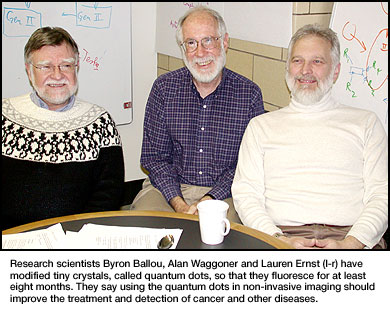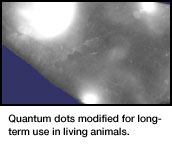|
|
||||
|
|

Modified Quantum Dots Could Lead to Improved Treatments for Cancer By modifying the surface of tiny, fluorescent crystals called quantum dots, Carnegie Mellon scientists may have made an incremental "promising step" toward the long-term goal of using these agents to detect the location of diseases such as cancer.
The scientists altered quantum dots to fluoresce for at least eight months in a living animal, a technological feat that should improve long-term studies in mammals and help pave the way for clinical applications. Eight months is the longest that anyone has observed quantum dot fluorescence in a living animal, according to the researchers, who work at the Mellon College of Science's Molecular Biosensor and Imaging Center (MBIC).
Ballou and his colleagues, in collaboration with the Quantum Dot Corporation, found that coating the company's quantum dots (Qdot® Particles) with one type of polymer prevented them from breaking down inside a living mouse. By adding a second polymer coat, colleague Lauren Ernst showed that they could prolong the time quantum dots circulate within the animal. Both these features enabled the quantum dots to deposit effectively within tissues, Ballou noted.
"Because uncoated quantum dots are too fragile for most biological studies in living animals, the coating is the most critical step," explained Ballou. "The new coatings allowed us to observe quantum dots much longer than previously demonstrated."
The MBIC team found that their modified quantum dots collect in immune cells that normally scavenge debris within the body. They plan to extend their research by targeting quantum dots to other cell types. In principal, scientists could modify the surface of these long-lived quantum dots by attaching molecules on their surface that target tumors. Acting as molecular beacons, these quantum dots would enable physicians to image tumors more effectively and to remove cancers with greater accuracy, Ballou said. Their quantum dots also could be modified with molecules to create implantable biosensors for a range of clinical applications, such as reporting how tumors respond to therapy. "Before these applications can happen, quantum dots must first be modified so that they remain in circulation long enough, and we must ensure that quantum dots don't harm healthy cells," he said. MBIC is recognized worldwide for its work in revolutionizing light microscopy and fluorescent probes for live cell imaging. The center's current focus involves the development of instrumentation and chemistry systems for biological research and medicine. Founded in 1998, Quantum Dot Corporation (QDC) and its advisors are the world's leading experts in semiconductor nanocrystal (Qdot®) technology and its application in biology. The research was funded by the National Institutes of Health.
Amy Pavlak
|
||
|
Carnegie Mellon Home |
||||
 "Our findings are a promising step toward using quantum dots for non-invasive imaging in humans to monitor and treat diseases such as cancer," said research scientist Byron Ballou, who was part of a team that reported their results in the January/February issue of Bioconjugate Chemistry. "Using our modified quantum dots, we were able to non-invasively image structures in living mice by fluorescence, then prove that the quantum dots were present by electron microscopy. No other fluorescent label lets you verify its exact location on scales from the whole animal to molecular dimensions."
"Our findings are a promising step toward using quantum dots for non-invasive imaging in humans to monitor and treat diseases such as cancer," said research scientist Byron Ballou, who was part of a team that reported their results in the January/February issue of Bioconjugate Chemistry. "Using our modified quantum dots, we were able to non-invasively image structures in living mice by fluorescence, then prove that the quantum dots were present by electron microscopy. No other fluorescent label lets you verify its exact location on scales from the whole animal to molecular dimensions."
 First commercialized by the Quantum Dot Corporation in 2002, Qdot Particles are nanosized crystalline particles composed of a few hundred to a few thousand atoms of a semiconductor material (typically cadmium selenide). Quantum dots emit light in a variety of colors, depending on size.
First commercialized by the Quantum Dot Corporation in 2002, Qdot Particles are nanosized crystalline particles composed of a few hundred to a few thousand atoms of a semiconductor material (typically cadmium selenide). Quantum dots emit light in a variety of colors, depending on size.